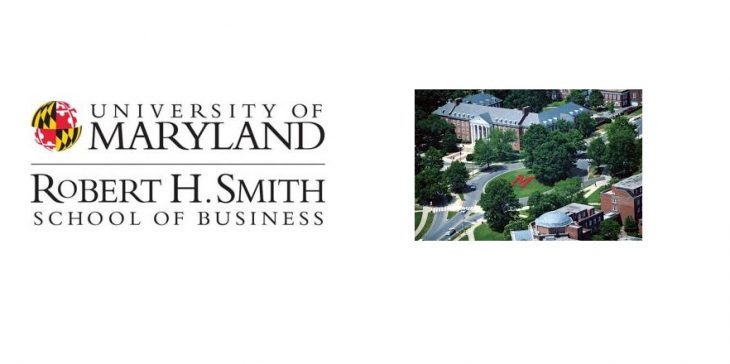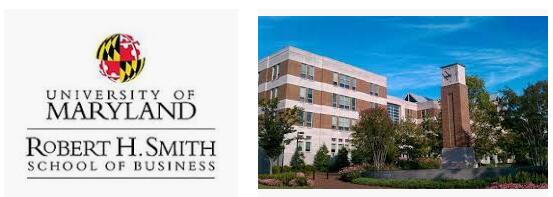Search top business school MBA programs in the state of Maryland. Find latest rankings of MBA schools national wide and state wide. For detailed admissions statistics and graduate employment rate, check the following table for each top-ranked business college within Maryland, with acceptance rate, average GPA and GMAT scores, as well as well tuition and starting salary information of all best MBA universities in Maryland.
The University of Maryland is home to one of the most highly acclaimed business schools in the country. The Robert H. Smith School of Business offers a variety of undergraduate and graduate degrees in areas such as accounting, finance, marketing, information systems and operations management. The school also offers specialized certificate programs in areas such as entrepreneurship, healthcare administration and nonprofit management. UMD’s Smith School of Business also offers a variety of research opportunities for students as well as opportunities to participate in case studies and competitions.
Johns Hopkins University is another prestigious business school located in Maryland that provides an array of undergraduate and graduate degree programs in accounting, finance, marketing and other areas. Students can choose to pursue a Master’s Degree or MBA program at the Johns Hopkins Carey Business School which focuses on developing leadership skills through experiential learning opportunities such as internships, case competitions and coursework focused on real-world application. In addition to the traditional degree options, Johns Hopkins also offers specialized certificates in areas such as healthcare analytics or digital marketing strategy.
The University of Baltimore is another great option for those looking to pursue their business degree in Maryland. With an AACSB-accredited Merrick School of Business students can choose from a variety of undergraduate and graduate degrees with concentrations such as accounting, economics & finance, entrepreneurship & family enterprise management and marketing. The college also offers several certificate programs geared towards professionals looking to gain specialized knowledge or skills including the Nonprofit Leadership Certificate Program or the Cybersecurity Certificate Program which can be completed entirely online or through a hybrid format combining some on-campus components with online coursework.
Finally, Towson University’s College of Business & Economics provides students with an array of undergraduate and graduate degrees with concentrations ranging from accounting to hospitality & tourism management to international business & trade among others. In addition they offer several certificate programs including their Professional Accounting Certificate Program which allows students to gain valuable knowledge related to taxation procedures while preparing them for professional certifications like CPA exams or CMA exams upon completion.
In conclusion, there are many highly respected business schools located throughout Maryland offering an array of undergraduate and graduate degrees along with various certificate programs tailored towards gaining specialized knowledge or skills within certain fields like accounting or cybersecurity. Each school has its own unique advantages so it is important that potential students do their research before deciding on where they want to pursue their business degree.

| National Ranking | Best Business MBA Programs |
| 46 | University of Maryland–College Park (Smith) (College Park, MD) Acceptance rate: 41.4% Average GMAT score: 661 Average undergraduate GPA: 3.31 Tuition: In-state, full-time: $38,475 per year; Out-of-state, full-time: $47,448 per year Enrollment (full-time): 261 Average starting salary and bonus: $99,694 Full-time graduates employed at graduation: 45.6%  |
Maryland is a state located in the Mid-Atlantic region of the United States. It is bordered by Virginia to the south, Pennsylvania to the north, Delaware to the east, and West Virginia and Washington D.C. to the west. It is the 19th most populous state in the United States with a population of approximately 6 million people as of 2020. The capital of Maryland is Annapolis and its largest city is Baltimore. Maryland was originally part of Virginia at its founding in 1632 and became a state on April 28, 1788 as part of the Union during the Revolutionary War. It is known as “The Old Line State” due to its role in defending America during that time period. Agriculture has been an important part of Maryland’s economy for many years with tobacco being one of its primary crops. Other important economic sectors include manufacturing, banking, technology, shipping and defense contracting. Maryland also has an extensive network of highways that stretch from border to border making it easy for people to travel throughout the state quickly and efficiently. In addition to its agricultural industry, Maryland has become a popular tourist destination due to its beautiful coastline, numerous outdoor activities such as hiking, camping and fishing and historical sites such as Fort McHenry National Monument & Historic Shrine. There are also many cultural events taking place throughout Maryland including festivals celebrating art, music, food and history.
Early History of Maryland
It is believed that people lived in Maryland for about 12,000 years ago. The main occupations of the Indians were hunting, fishing and, to a lesser extent, agriculture. By the time the European colonization of America began, the Algonquian peoples Nantikouk (on the eastern shore of the Chesapeake Bay), Piscataway (in the area of modern Baltimore and Washington) and Shawnee (in the west) lived here.
In 1524, the Italian Giovanni da Verrazano sailed along the Atlantic coast of America from North Carolina to Rhode Island, but he did not notice the entrance to the Chesapeake Bay.
In 1608, Captain John Smith, one of the leaders of the English colony of Virginia, was the first European to explore the coast of the Chesapeake Bay. The maps and descriptions of the area created by John Smith later played a crucial role in the development of the region.
In 1629, George Calvert, 1st Baron Baltimore, turned to the English King Charles 1 with a request to grant him the rights to create a new colony in America, located north of Virginia. Calvert, who was previously Secretary of State of England and became a baron after receiving the estate of Baltimore in Ireland from the king, already had experience in organizing a settlement in America, though not very unsuccessful. Back in 1621, he founded the Avalon colony on the island of Newfoundland, but because of the harsh climate, it did not develop and Calvert wanted to settle further south, where natural conditions were better suited for agriculture. In 1625, Calvert resigned and converted to Catholicism. One of the goals that he pursued in founding a new colony was the desire to create a safe haven for English Catholics across the ocean.
George Calvert died in April 1632, but his work was continued by his eldest son, the second Baron Baltimore Cecilius (Cecil) Calvert (it was in his honor that the city of Baltimore was later named). In June 1632, only five weeks after his father’s death, he received a patent to establish a new colony named after Queen Henrietta Maria. In November 1633, the first two ships with settlers, led by Cecil’s younger brother, Leonard Calvert, set off for America, and on March 25, 1634, the colonists landed on St. Clement’s Island (this day is celebrated in our time as “Maryland Day”).
The first capital of Maryland was the city of St. Mary City, built on the western shore of the Chesapeake Bay on land bought from the Indians (in general, the residents of the new colony tried to maintain good neighborly relations with the indigenous peoples in those years).
